Pivots
Sommerakademie Paul Klee residents respond to questions pertaining to "Art & Statecraft: How, Why and Where".
Tirdad Zolghadr: At the Sommerakademie Paul Klee (SPK), critique was discussed as a more established, traditional form of artistic/curatorial agency. Others included teaching, institution-building, propaganda, divestment (strikes, boycotts), or robinhoodism (smuggling resources to more worthy recipients). Are we underestimating critique? What is our de facto skill set, realistically speaking? What works?
João Enxuto & Erica Love: Critique gets trivialized because it is assumed to operate strictly within a symbolic order, rather than as an operation that produces material results, such as the alternative forms listed above: teaching, institution-building, divestment, etc. Critique has been the artistic/curatorial toolkit to identify and respond to asymmetric power relations: to speak truth to power or to undercut cultural hegemony. Critical theory is the de-facto rubric for Contemporary Art's (CA) academic training in recent decades. This proliferation wove critique into the expanding fabric of the art field, including rhetoric and displays on behalf of galleries, auction houses, and art fairs. The field's superstructure kept steady, as power asymmetries expanded throughout the pandemic period.
What continues to appeal to us about the SPK's organizing principle of "Statecraft" is a tacit recognition of limits to artistic critique and of the fact that such shortcomings can be redressed by seizing available levers to impact broader social and political struggles. These activities can be channelled through existing governance, policy, and administrative systems. The de-facto artistic skills for this work is content production, propaganda, and strategic planning. Unfortunately, the current media environment is oversaturated with noise, which has left us engaged in a low-intensity ideological war that aims to distract and exhaust the will to tackle structural problems (institution building) and existential threats (climate crisis).
Tracy Jeanne Rosenthal: I'd argue that the de-facto artistic skillset is profoundly individualist, and well-suited to critique. I think of this in my individual writing practice, which often engages satire, a literary genre that shares some contradictions with critique. Satire is indeed political, but "political" as an adjective just describes a feature of the form, more or less (what a work is about). In current literature and art discourses, we often rely on "political" as a justification for a work’s privileged place in an overall attention economy, and thereby enhance its value. Where it gets dangerous is in our tendency to believe our own campaigns. In some ways, the role of the contemporary artist here is like that of the postmodern literary critic: the "unmasker". We often think we've sufficiently embarrassed the operation of unmasking, but there are a few things that keep it around. One is that it's highly enjoyable. Who doesn't love an AHA moment. Who doesn't love to complain. I don't really have a problem with critique calcifying into edu-tainment. I write satire because I like satire! Also because you can go it alone. This is why the art industry's understanding of the "political" fails against the work of politics. You can't do politics alone. I write from my cynicism about politics; I organize in the tenants union to do it. The forms of political agency available to artists—strikes, boycotts, unionization efforts, building autonomous institutions—are available to everyone and anyone, and to participate fully in those forms means making yourself replaceable within them.
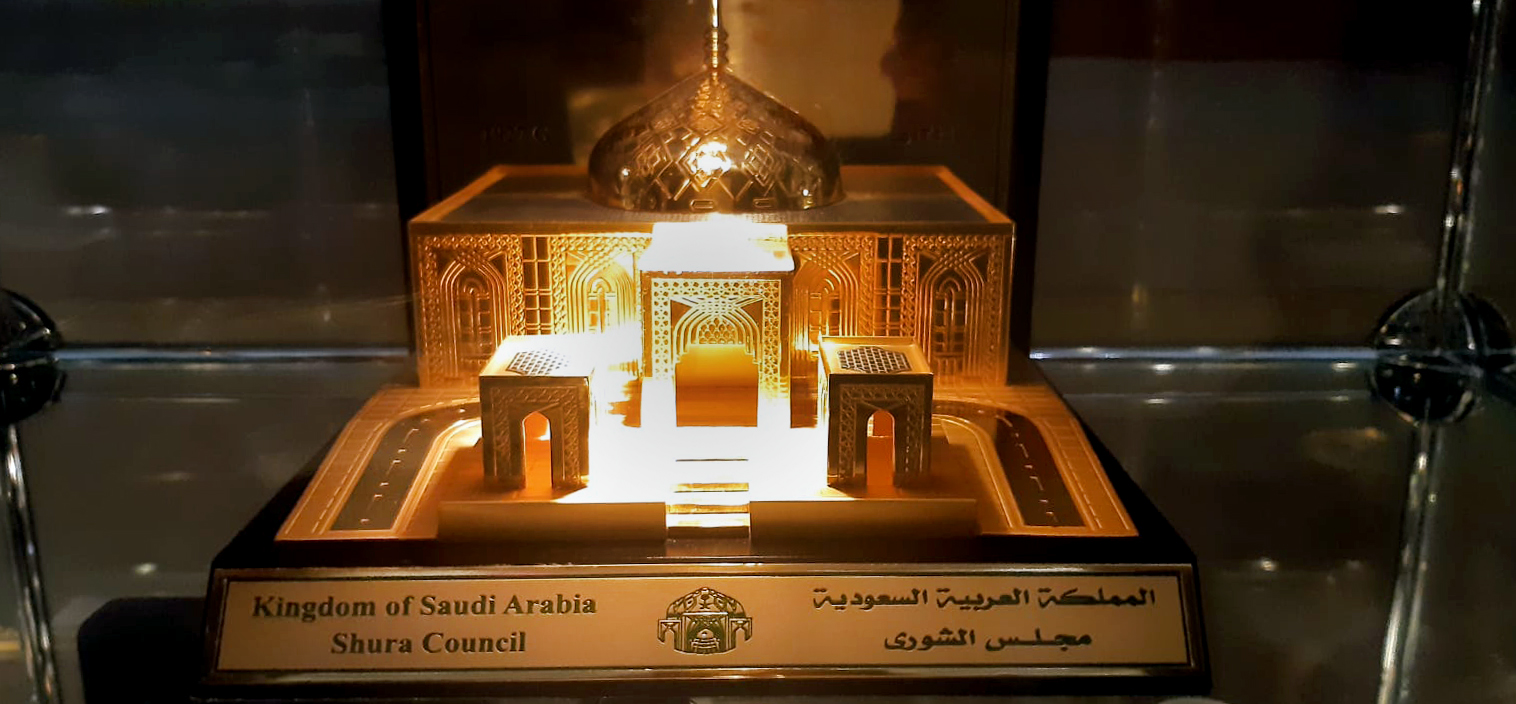
Airi Triisberg: I come from a context where the tradition of intellectual or political critique is quite dominant; the legacy of Soviet Union, where possibilities of civic engagement were limited. I associate the notion of critique with a solo figure of the artist or intellectual who critically reflects on matters of society from an assumed position of authority. This version of public intellectual usually rejects collectivity. In post-Soviet contexts, such as Estonia, collectivity seems to be a banished concept in general, so for me, it has taken a lot of time and effort to learn and experience collective forms of political agency – such as building social movements, solidarity economies and counter-publics. That said, in the meantime, I've realised it was not only my post-Soviet upbringing that left me badly equipped for collective organising. Art workers are notoriously unpractised in all that. When asked "what works", my first answer is movement building. Art practitioners often dismiss this option, because movement politics does not align with some of the core values in the art sector, such as individual authorship, artistic autonomy over political autonomy, and the idea of an artistic sphere as an exceptional one in society at large.
Olivia Abächerli: Yes, I can relate to that feeling of being badly equipped for collective organizing. The one is about becoming politicized, the other is about entering an art discourse. What is crucial is the specificity of the art's and/or activist's sphere one happens to enter, and the question of whether they intersect. If the environment of your politicization, and your becoming-artist, are two separate social spheres, then you might need to move between radically different social circles and practices. For the sake of inner coherence, you might really need to develop and define skill sets and political strategies as an artist from scratch. Maybe the process of that definition becomes the engine, or even the motive, of a practice. I’ve been hoping, for quite a while, that art's potential could lie in fabulation; in construction instead of deconstruction, in this wonderfully megalomaniac notion of world-building. For now, I've got a sense that dealing with complexity, and simply understanding it, is helpful. So back to square one: critique. Even if one should still try to speak to a diverse audience, beyond the cluster.
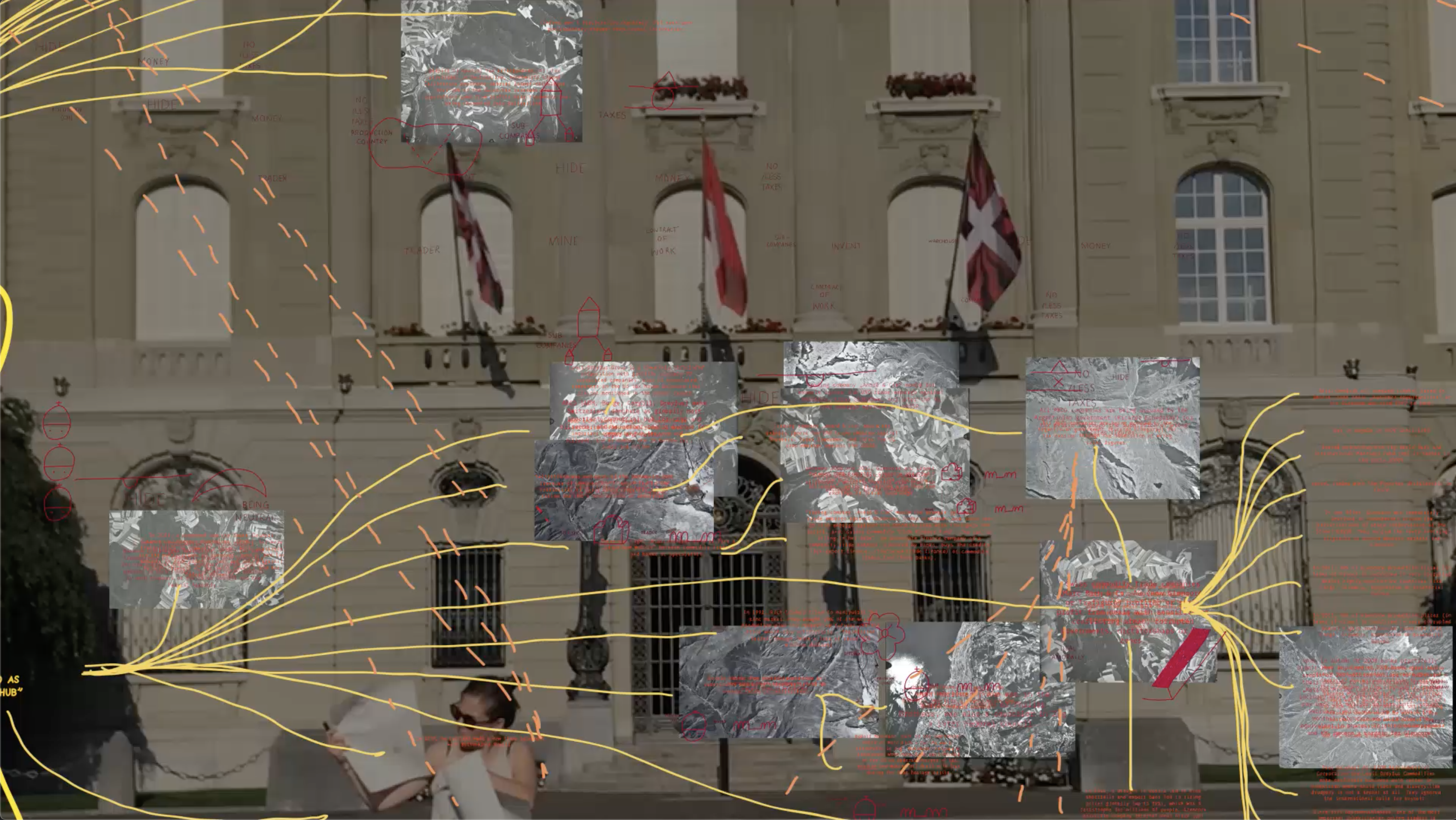
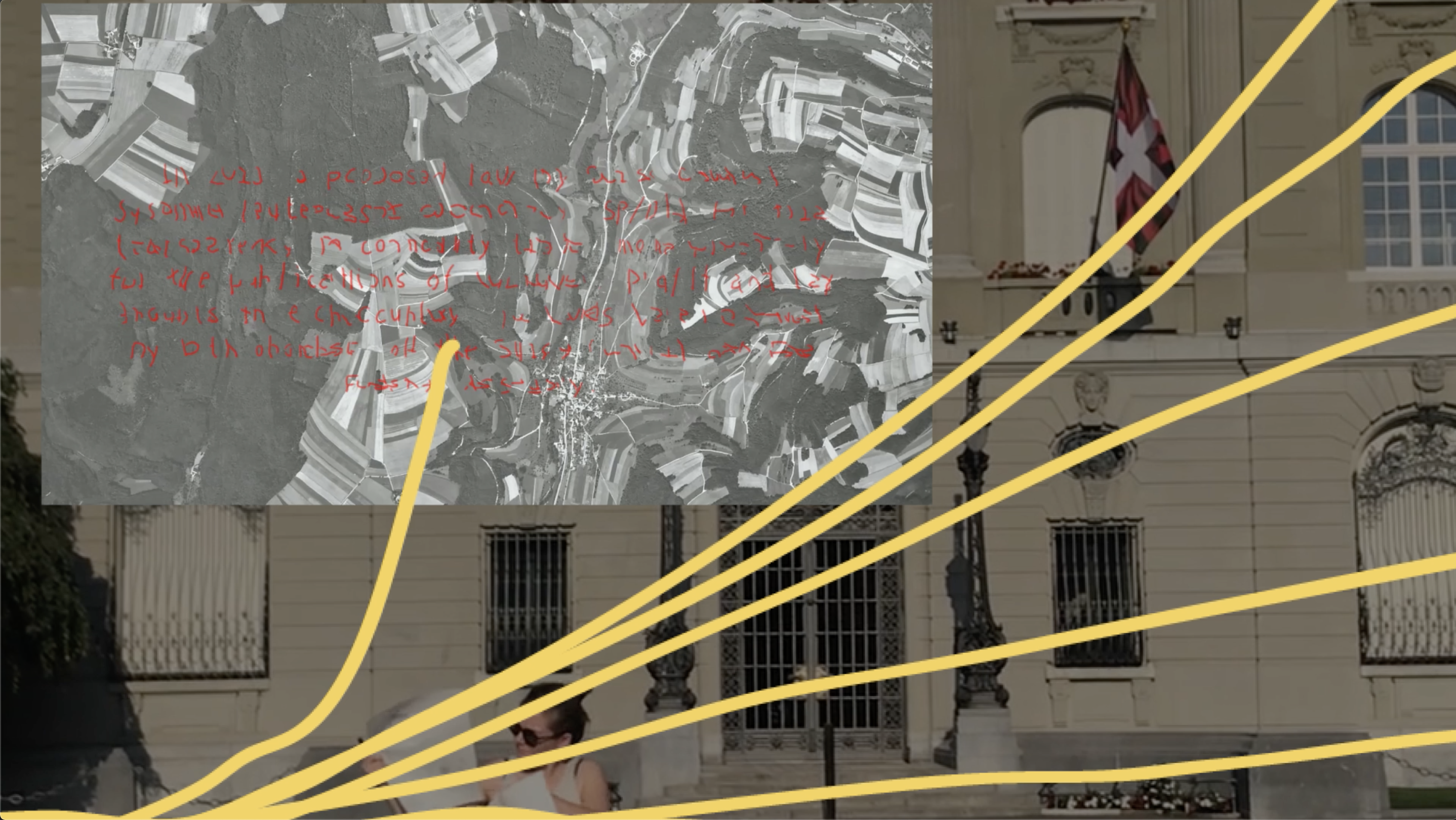

Aarti Sunder: I would largely agree with what was said about privileging artistic autonomy over political autonomy, but I'm not sure to what degree artists actually believe they have that sense of power over production narratives and/or institutional frameworks. Unless art is inclusive of people who are embedded in other professions, unless it allows for a form of cross-professional collaboration, world-building will fall short of what artists themselves want to do when they say "speculation". This immediately clarifies how much or how little agency we have as practitioners. It also helps form a material base for thinking "construction".
Felipe Castelblanco: In 2020, while most communities across the world were shaken with a global pandemic for which nobody had answers, highly anticipated cultural and intellectual gatherings (including our very own SPK) moved to online formats. For the most part, such online events quickly turned engagement into exhaustion, and clarity and interaction into confusing overdoses of screen time, but I guess it was a necessary trial.
Soon, online events turned every one of us into analysts or overwhelmed listeners. The so-called critical tools, the tools of the cultural critic, were at odds with the humble acceptance of the reality we all, as humanity, are still facing. In this disorienting reality (from soaring temperatures, and a global pandemic, to anthropogenic metabolism and mob-cheering politicians), nobody can be truly lucid. Academic discourse has become a self-serving weapon, even when genuinely progressive, and the capacity of cultural producers to make sense of anything has been met with profound distrust. Many of the epistemic structures which support our disciplines, aesthetics and codes of criticism in the West are still tainted with gendered, colonial biases. Herein lies the pitfall of our quest for intelligibility and critical discourse today; it's as dangerous as using expired medicines to treat illness. Which alternatives, tools and tactics – other than critique – can we deploy while seeking remedy and healing via culture?
Dorothee Kreutzfeldt: I guess you're asking for the "we" to be situated. The question of the artist's tool set. And how we may align ourselves actively in battles for emancipation and justice, and avoid narrow 'progressive' curricula, or pretense of 'commonalities'. It implies a rethink of how CA connects to the lived experience of people, ecologies and governing structures. But it also concerns where the arts do not fit, and are not easily readable as remedy, creative elixir or packaged exhibition – and how this may lead to significant cultural work and critical technologies.
I often think of Rubén Gaztambide-Fernández' questions about what the arts do, in the context of education, and the idea of art's radical potential, even when tethered to institutional discourses and social relations. He takes issue with (euro-centric) artistic definitions of what the arts do, whether intrinsically, or as an "instrument", arguing for "expressive, conceptual and imaginative work; transforming individuals and society; raising consciousness, knowledge production, aesthetic experience." (Gaztambide-Fernández, 2013). "Rather than thinking about the arts as doing something to people," he argues, "we should think about artistic forms as something people do." (Ibid.)
When applying to the South African National Arts Council for funding, you are asked to indicate the "direct beneficiaries", their gender, race, etc. Preference is given to proposals that "promote environmental sustainability, nation-building and social cohesion, and have a strong community base, conceived in collaboration with others working in similar fields. Proposed projects must demonstrate impact and value for the communities in which they operate." By default, "impact" is defined in terms of what the arts do and service.
In this regard, what are toolsets, tactics and agenda grounded in? We may foreground decolonial, feminist and queer practices. We may critique inequality in high-end curated shows, even while selling work to private collectors without asking questions. We may trade sign-paintings of sunsets at the side of the road. Rigorous critique, subversion and irresponsibility in our field are part of a shifting dynamic. They are as nuanced as the colonial legacies and debt economies on the continent themselves. Over recent years, significant black student protest movements have emerged, and progressive scholars, [1] often with close links to workers movements, civic and environmental organisations. Working at university/art school (WITS) offers invaluable room for experimentation and generative research, as part of a community of peers. Students and colleagues push the potential of 'radical' critique. Despite or because of a compromised academic set-up within statecraft, with high study fees, performance-based management and declining state subsidies. And despite replicating western models of art school in a metropolitan African context.
Fadwa Naamna: The art world (especially in the North and the West) has been busy trying to make venues truly public and democratic. And exploring ways in which CA can engage in societal and political struggles. A paradox emerges when institutions and practitioners try to do so with the language and means of art – that is, by educating the public to be "critical", and associating this very criticality with teaching art to the public. As with other things, critique through CA requires a historical understanding. But since the majority know little about such particularities, the said idea of democracy-in-resistance proves to be a false premise.
Despite the positive intentions of this kind of engagement, its logic is often overly designed and top-down. By assuming CA has the power to educate the public, and lead change, it positions itself as superior. As genuine struggles and resistance emerge from oppressed or deprived environments, how can change be achieved without the protagonists being in the forefront of their own struggle? This is a very longstanding debate. In her 1898 publication Reform or Revolution, Rosa Luxemburg already argues that a socialist society cannot be created by trade unions or reformist political parties, this despite their importance in promoting class consciousness. She endorses a bottom-up type of revolutionary reforms that is led by laborers themselves. In other words, the life and labor of proletarians becomes a field of study and leadership in and of itself.
TZ: The above strategies are one thing. Their aims are another. Let alone the ideologies and agendas that define these aims. Many artworld forums discuss methods and artist agency etc. None discuss agendas. The fear of discovering enormous differences between us is very justified. Given the statecraft topic, should we at least try, or do we have enough on our plates? Would hard Left principles stand a chance, or is artworld liberalism more helpful? Do we even need to agree on the bigger picture, or are the smaller battles quite enough, for now, thank you very much?
Tracy Jeanne Rosenthal: What's really at stake in this question is whether or not we're willing to be communists. Not intellectuals, not researchers, not service workers, not activists, but actually organizing to bring about communism, or whatever you want to call a system that doesn't mete out human rights based on our ability to pay, destroying our world in the process. Art is one of the only industries in the world where anti-capitalist rhetoric is so pervasive. But most people here simply want a nicer capitalist life. I'm not saying this to begrudge the desire, but to clarify that many in the art industry wage no antagonism towards capitalism. The liberal project substitutes our capacity to take power with an ability to "have a voice", "be in dialog", or "express ourselves", and is incredibly adept at protecting the interests of the powerful.
The liberalism of art suggests political conviction could be reduced to a matter of taste, rather than struggle. (This is critique's seat at the table.) When in the art industry, as in many workplaces, McCarthyism is often the rule. Unions are ousted, boycotters blacklisted, and plenty of would-be organizers abandon ship. I'm also particularly interested in how the affects of hope, sincerity and trust, all required for organizing, have been maligned in the industry, to the benefit of irony, detachment and cool. Here, a realist approach to utopianism (you need other people to join you if you actually want to see a different world) is dismissed as folksy or backwards, in favor of glitzy technocracy, collaborationism, nihilism.
João Enxuto & Erica Love: Absolutely. Radical claims are the stock-in-trade of the art field, and there is an allergy to even speaking of communism. This also has to do with the troubled legacy of Soviet communism, and the capitalist expansion of the art field, post-1989, as a global phenomenon. Furthermore, prestigious institutions in the field remain mostly accessible to those with economic means. They were once limited to the Euro-Americas, but now feature wherever capitalism has spread its extractive roots. There is little incentive for a structurally disruptive agenda if the art field is already serving the interests of its most powerful constituents.
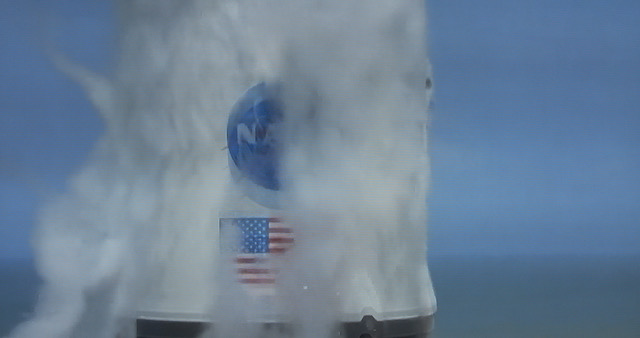
Fadwa Naamna: Both Left-wing politics and the art world suffer from a solidarity problem. The solidarity we're witnessing is based on resemblances. It eradicates the natural differences between us. This logic is similar to what Richard Rorty described in his 1989 study Contingency, Irony, and Solidarity: "solidarity is strongest when those with whom solidarity is expressed are thought of as 'one of us', where 'us' means something smaller and more local than the human race". This type of Leftist critique clashes with more rigid discussions of hegemony, identity, place-based politics, micro-community, localized battles, and counterpublics. With such approaches, the Left has been unintentionally serving the Ultra-Right project.
Consider the 2019 advisory resolution of the German Parliament, which weaponizes anti-Semitism and condemns cultural institutions and practitioners who do not reject the Palestinian-led Boycott, Divestment and Sanctions movement (BDS). Such incidents conflate Rightist and Leftist ideologies, and limit freedom of speech. Artists are denied public support, and institutional directors are under extreme pressure to stay quiet. In a country that constitutionally guarantees civilian freedoms and equalities, this situation proves to be a failure in democracy.
Focusing on identity-based unity is unproductive, and doesn't challenge any Rightist vision. Asad Haidar's Mistaken Identity (2018) shows how contemporary identity politics neutralizes anti-racist movements, instead of supporting the struggle against oppression and racism. He compares how black freedom movements perceived racism and capitalism as two sides of the same coin, and how this vision has been replaced with myopic micro-battles.
A "reflective solidarity", as suggested by Jodi Dean, is based on discursive interconnections, where differences become visible through recognition and correspondence, questioning and discussion, as well as openness and accountability. And, going back to the context of CA, its critique can actually enhance solidarity when it truly encompasses differences, by providing a "third space" where contradictory perspectives can be positioned in conversation.
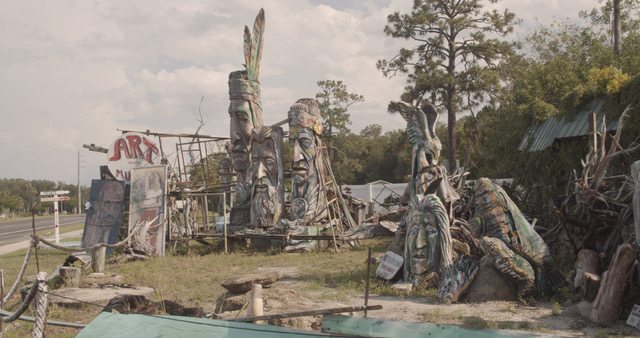
Felipe Castelblanco: If 2020 was about anything in particular, I would say the words "distribution" and "redistribution" were coming up repeatedly on my radar. From the challenges of distributing vaccines to far-off populations (even in "wealthy nations"), to redistributing public funding previously assigned to defence or policing – and rerouting it to severely disrupted health services. Social interactions, time spent with loved ones, or day-to-day tasks all had to wrestle with a total redistribution of space. As we know, not all forms of redistribution were designed to evenly spread resources, but to favor more complex forms of accumulation and privilege.
Throughout the year, I felt a deep sense of loss, and a need for a complete overhaul of my entire epistemic ground. The sudden loss of space (public spaces, spaces of gathering, teaching spaces, cultural spaces), and its clumsy translation into online space, became one of my biggest concerns. Well-intentioned invitations to virtual happenings – even on behalf of peers who are gifted with sophisticated methods of critical thinking – revealed that public life is about to be privatized and conditioned by data flows and servers, by spaces where "free" and "public" become mere catchwords for more elaborate forms of extraction and profit.
Dorothee Kreutzfeldt: It feels impossible to plot a view into the future, and speculatively provide a perspective to assess current complexities and struggles. Perhaps I have been too preoccupied, serious and distracted. It seems obvious that this episode is a significant incision, the dimensions of which will only emerge fully over this coming decade. Statecraft and its counter-mechanisms may shapeshift from within a structural crisis that manufactures inequality, and keeps a political and economic elite intact.
Listening to the paternalistic tone of government announcements, which always begin with "Dear fellow South Africans…", the national agenda remains in the foreground, despite the porousness of borders, and the mobility of the virus. Over New Year, there was a disastrous breakdown of cross-border traffic between South Africa and Zimbabwe, one of the busiest border crossings between the two countries. It led to long queues and several deaths from dehydration.
My colleague Godfrey Mahlangu evokes the late, revered prophet, healer and artist Credo Mutwa. Mutwa’s predictions are well-documented; he insisted we "feel what is going on in the world, see the future dormant in the stone, not listen to the newspaper". Perhaps we need to switch tools at hand, to intuit more sharply, filter information with different organs or sensors, so as to triangulate and co-shape what is at stake.
Olivia Abächerli: Why is one political to begin with, or, to put it differently, why would one be political? The pursuit of a politically relevant agenda might stem from an inner urge. I can only speak from a personal position; being "Swiss" feels like living in a warm jacket of innocence, at least in some ways. But the jacket feels wrong. What the hell are we doing here? What are we entangled in? What do I cause? There's a vague sense that something's not right, and this can only be countered by understanding a complicated situation, or by organizing/activism/political action. How artists think they might have an impact is an individual matter. But it's interesting that there’s little to no macro-political confrontation in CA. Is that because we have yet to negotiate the details of shared political goals?
Aarti Sunder: If we are interested in making claims, then it's imperative to at least stand by them for a brief period of time, and do the work it takes to justify them. Then again, what exactly are those claims? It's a kind of see-saw situation: working towards smaller goals is a much-needed method that doesn't stand in opposition to having a larger agenda. The tough part is trying to make it explicit, and determine what exactly it is. But that too never takes place in isolation – it's more of an amalgamation of tiny claims.
What is clear is that it's impossible to steer clear of statecraft. To actually say I'm not involved. Even prior to COVID 19, the protests around the world (one would think they were meticulously coordinated, but weren’t) are testament to the fact that you have to use your own expertise/skillsets/professional connections, to take part in whatever way.
Maybe the lack of articulated conflict within our sphere goes back to what Airi was saying earlier. Insofar as CA is focused on personal experiences, it is difficult to take anyone to task about what is being said in their work. At the same time, I am not for negating personal experiences at all. Can't lived experience account for how statecraft operates? This is how collective imaginations are born and played out.
Airi Triisberg: I think the lack of conversations about potential common agendas, and the lack of macro-political conflicts, shows that some common ground already exists, or is assumed to exist. From my point of view, it is perhaps more curious that this common agenda often remains unnamed, or is described in misleading terms, whereas essentially it is indeed mostly liberalism.
TZ: CA is already a means to statecraft in many ways: schooling, urban development, international diplomacy, labor markets etc. Would these settings be better off without us? Or can art be a means to smarter teaching, affordable cities, international dialogue, comparatively decent jobs? In other words, where do you sense the importance of the work you do: in studios, galleries, schools, universities, city neighborhoods, museums, social media … surely the "Art & Statecraft" conversation make more sense in some places than in others.
Olivia Abächerli: I would advocate the idea of serendipity. To keep doing something with virtuosity, but without clear goals, until you make a discovery, purely by chance. Humankind doesn't need the framework of CA to do critique, speculation, or experimentation. What it needs in order to pursue these things seriously, on a larger scale, is time and energy. And money. Hence the need for serendipity and speculation. Art is what comes closest to this much-needed space.
Aarti Sunder: Sometimes art doesn't have to respond to everything. It may not the best place to do certain things, and that is okay. To speak to Olivia's point, happy chances are important, and that is intrinsic to the craft of making. I wonder if crafting an agenda follows the same logic – it is never only your agenda, it is always embedded in a history and future that is communal.
Airi Triisberg: This brings to mind the issue state funding. Art practices have also been instrumentalized due to their dependency on public funding. What I miss very much in CA are practices that would contribute to the collective process of creating autonomy both from capital and the state.
Tracy Jeanne Rosenthal: Most salient to me here is the role of CA in urban development. Art Spaces in city-sanctioned Arts Districts aren't just canaries in the coal mine of gentrification. Rebranding the crest between disinvestment and speculation, they are conduits for displacement and replacement. Participating in a boycott of galleries moving into the poor Latinx neighborhood of Boyle Heights clarified the conflict between art's anticapitalist rhetoric and its material impact. We had gallery directors collaborating with real estate developers, requesting a larger police presence, we had others claiming that offering representation to a few artists of color was a worthwhile trade-off for their structural impact. I got my first "outside agitator" accusation, a well-known, historically anti-Semitic tactic. It was a painful process, losing social standing, and financial support from institutions, but what I gained was a much broader sense of belonging, within the community I wanted to make, and my obligations toward it. The boycott was about drawing a line to protect a community from displacement. I was compelled to keep it not because of a vendetta against the art industry, but because I recognized its possible leverage – the strategic proximity to press, an over-read and underpaid labor force playing a starring role in city planning as economic growth, but who could – who still can - go off script.
João Enxuto and Erica Love: It is one thing to act in relation to the material impacts of CA – to conceive of CA simply as an infrastructure – and another to continue to produce work within its established frameworks. In other words, it might be enough for CA to remain in its own lane, and to make demands for more rigorously equitable criteria for the production of work, teaching, and exhibition making. This is undoubtedly a smaller-scale struggle from within a system. We know the art field is shaped through its entanglements with governmental policy, finance, etc., but at each step, decisions can be made to better manage how CA interfaces with exogenous factors. This matters to us, because we continue to work through visual media to demonstrate the complex entanglements made manifest by the impact of CA. It has not been an easy process to convey the intricacies of power without being reductive or preachy. We aren't sure whether what we do is "hyperstition", or merely propaganda.
Tracy Jeanne Rosenthal: I'm selfishly interested in propaganda—could it be as functional as religious art or porn? Propaganda does imply an accountability, a movement or its institutions having final say on content and form. These statecraft tools of accountability, regulation and institution-building can guide us away from metaphorical notions of "the political" and towards functional realpolitik. We don't have to abandon an aesthetic interest, sensibility or even skillset. Tenants unions, for example, are aesthetic interventions; they reshape the material of social life. During the pandemic, the L.A. Tenants Union's local chapter in Boyle Heights has been distributing food, organizing tenants who can't pay rent, using direct action to defend neighbors from evictions. There is an extremity of aesthetic creativity, ingenuity, and vision that goes into the difficult collective processes of shaping an institution like that. It's just that we might have to de-prioritize our attachments to individual authorship, so we make room for other kinds of abundance.
Felipe Castelblanco: One might also ask: how could artists and cultural producers reimagine society in 2020? To which I'd answer that here, in the Northern hemisphere, we simply cannot. Our museums, careers, biennials and precarious economies are not pandemic-proof. We fail to embrace an aesthetics of the undoing, to sculpt policy, to perform governance, or forgo our own share of the market. We form weak alliances and only make art for each other.
If we could only stop being cultural vampires, and look around, learn from other hemispheres and other histories, we would remember that a city, a state, a new world can be crafted by weaving threads together, by joining single fibres that add up to and support the whole. If a single thread pulls too hard, the entire fabric rips apart. Not all fibres are human, or discursive, but all of them embrace, twist and connect gently with one another. Each is a whole, and a collective, accountable to both the single thread – and to the fabric in its entirety. This world is not inhabited but realized, every day, by the weaver, the wearer and the tension that holds it all together. This world is ruled by a new jurisprudence which is not only spoken but felt, stretched, finely woven, self-evident and all-encompassing, for humans and non-humans alike. In such a world, nobody can forecast the economy, politics, nor even the weather. All forms of divination or speculation are restricted to children under ten (or elders with the strength of a ten-year old). Fortunately, the patterns for such worlds have already been designed, we just prevent them from coming into being. If we didn't, we’d learn new weaving skills, like placing life over property, water over gold, and learn how to read the planet not through frontiers but through interwoven spaces.
This vision, of course, is nothing original, it's a mere description of the governance principles of indigenous nations fighting for land restitution, territorial rights and self-governance in places like the Colombian Amazon (home to the Inga, Kaméstâ and Quillacinga people). These communities are undergoing a long process of territorial resistance against the extractive interests of the Colombian state and foreign investment. Their daily practice is that of procuring the survival of their culture, and quietly forming an indigenous state, within the imposed state that currently exists.
TZ: So what does a residency have to do with any of this? The big impact of the pandemic on CA is the crass restriction on mobility. A mixed bag, possibly with zero impact beyond the pending vaccine. Some are hoping for more sincere engagement with local material context in the longer run. How realistic is that; imagine the year 2040. Will we remember 2020 as a gamechanger, or just a blip?
Airi Triisberg: I will probably remember 2015, not 2020, as the gamechanger in relation to mobility. Previously, I had not realised that the European border regime produces crass restrictions of mobility on other continents. I already knew free movement within the EU is maintained at the expense of militarizing the external borders, and I knew of mobility filters inside the Schengen region, such as racial profiling, largely unnoticed by privileged white EU citizens. Yet the European border crisis in 2015 also resulted in stricter procedures at the internal borders of, for example, ECOWAS (Economic Community of West African States), another area of hypothetical free movement. The EU continues to militarize and relocate its borders, and that needs to be addressed when discussing mobility.
From 2020, however, I'll remember some meaningful responses to the climate crisis, even on the part of art institutions. For example, in Finland, several art institutions created a new job position: an eco-coordinator, who measures the carbon footprint of each institution, and develops an action plan for reducing it. All these institutions, be they museums, residency programmes or festivals, came to the same finding: the main source of carbon emissions is flying (related to both travel and the transportation of artworks). So if the art world wants to help prevent climate change, those pictures of polluted landscapes are not enough. Practitioners need to travel less. Residencies can be reconciled with these principles, whereas art fairs and international biennial openings will hopefully be obsolete by 2040, over the course of the post-fossil transition.
Olivia Abächerli: I hope so too! And I also wonder about the role of the internet in 2040. There are no coherent numbers for Co2 emissions from air traffic, nor from the net – according to your sources, one is said to be higher than the other, so they must be on a similar scale. "Stream less videos" is not exactly a 2020 mantra, but it must become an issue at some point.
Aarti Sunder: In fact, only 2.5% of Co2 emissions come from global aviation. But strengthening local institutions is always a good thing. Everyone should invest in it. So if the pandemic enables this, then I'm all for it.
2019-2020 was an important period in that it facilitated classist/racist policies. The choice between "safe distancing" and to hell with the pandemic, we have to protest (see recent continual protests in India against new farm laws, for example) is not really a genuine choice. A different kind of governmentality is required, and the understanding that it’s fine to piss off the racist uncle in the family.
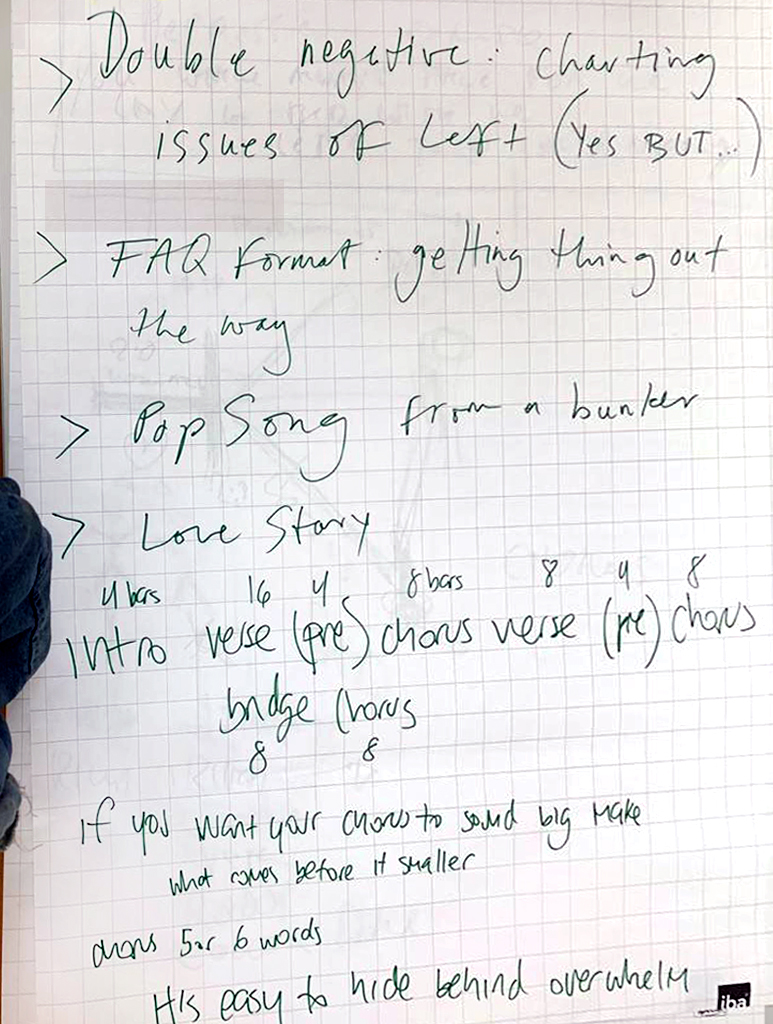
Photograph by Tracy Rosenthal
João Enxuto & Erica Love: It's difficult to predict the future – but for now, the wreckage of COVID 19 shows how unprepared states are to deal with a predictable public health crisis. The global CA class has long been threatening to cut their carbon footprint prior to 2020, but it took the force of a global pandemic to get it done. By staying in place, the limits of remote planning, learning, and sharing have been tested and, along with the convenience of staying put, we were accorded a novel brand of exhaustion. It is likely that this total stop has consequently fuelled a deeper desire for mobility and in-person contact.
The SPK model will undoubtedly be modified to accommodate the new normal but something stands to be lost when unfettered contact and casual interactions are constrained. In terms of an organizing theme, "Statecraft" will become more relevant post-COVID, as the expanding pathology of "nationalism" tests the coherence of nation-states and their institutions. The prospect of residencies at a distance stand little chance to flourish, even as the prospect of parachuting-in has regularly faced scrutiny. In the end, the sustained commitment of a program like the SPK is actually a good idea.
Tracy Jeanne Rosenthal: I love tactical internationalism as much as I love a vacation. Though the pandemic cut off the latter, it opened up a larger space for the former. Zoom can be harrowing, exhausting, plain boring, but at no other times have I attempted to attend a social housing teach-in in Manchester, a James Boggs reading group in NYC, and a screening in Beirut on the same day. It's possible, then, that the pandemic's restrictions will merely increase our decision fatigue, stretch thinner our commitment to where we are, help strip budget requirements for people and place. To trend-forecast, I would put some money on a resurgence of "togetherness-interventions" kind of social practice (to help people rebuild the muscle of their social-skills), and on the continued trendiness of domestic crafts, and maybe some terrible hegemony of viral metaphors ... Most interesting, though, will be charting how the art industry uptakes its lessons from mutual aid fundraising and a summer of riots. Will that newfound capacity to leverage resources amount to accountability toward social movements? Will "abolish the police" become "diversify the art industry"? But of course I'm also thinking about how wonderful it would be to swim in the Aare river again.
Felipe Castelblanco: For all the critical tools available, we seem determined to replace memory and exchange with storage and record. My fear is that after 2020, few of us will feel the need to think or act in real time, even though information outputs keep increasing. For example, while cultural events now seem accessible to anyone in the world, via Zoom links, Youtube and Instragram Live, the sheer assurance that a recording will be posted afterwards has been enough to justify our disengagement. Much of our intellectual sphere is quick to adapt to the new conditions, consume the online products, and transfer a culturally vibrant world to the server-world. No wonder our precarious economic activities are on the list of non-essential businesses.
If anything, today's cultural critique was revealed to be a paralyzing tool and a desk-bound activity, much closer to speculation, augmentation and futile divination than to usable practices for the here/now. The question remains as to how to participate in the clashing cultural spaces of today, and with which tools. While critique was the focus point throughout the intellectual spheres, it merely mirrors us cultural producers, ourselves, in all our complexity and our flaws.
Looking at 24-hour distributed newsrooms, like AP, CNN or DW, I wonder if we will soon be used to 24-hour streams of interconnected "culturally relevant critical forums'", of the likes of The Anthropocene Curriculum (HKW) or Critical Zones (ZKM). Perhaps, like the news broadcasts played in airports or waiting rooms, online critical engagement might soon become background noise. And as we seek ways to digitize the achievements of previous generations' hard fought battles (publicly funded art spaces, art schools, creative rights, etc.) we risk forgetting that it was coordinated action – in and for space – which afforded the power to record, produce, affect culture and transform mass behaviour.
Dorothee Kreutzfeldt: These last months have been marked by cycles of monthly announcements by presidential and ministerial offices, and by our (in)capacity to follow stringent lockdown regulations under the Disaster Management Act, including curfews, by-laws and prohibition. I often felt suspended in screen condition, processing my own panic, hope, isolation, constant communication, lack of sleep, and need for intimacy. With the increased presence of statecraft in our lives, there also has been a sharper comprehension of duress in the country, marked by massive job losses, rise in gender-based violence, food crises and systemic corruption. Public pressure on the government's biomedical response, and the demand to address the mismanagement of relief funds, social grants, health care and equipment has been constant. Concurrently, it mobilised enormous solidarity efforts, funds and campaigns in civil society and the private sector; for example through the C19 People's Coalition, around food insecurity, water supply, equal access to vaccines, and climate justice, organising community based solutions on the ground where the system failed.
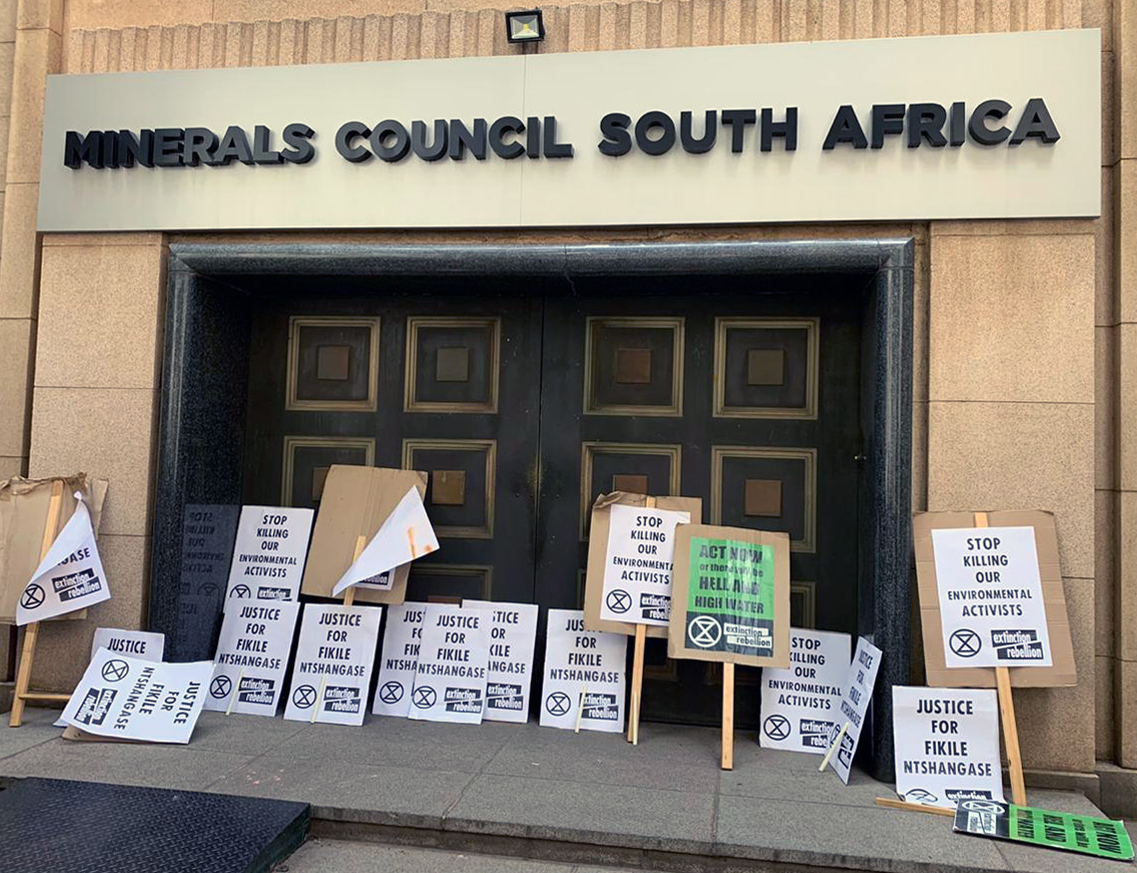
Minerals Council South Africa, Johannesburg. Organised by Extinction Rebellion South Africa. December 2020.
Photograph by Anita Khanna
In March last year, at the beginning of lockdown, musicians and artists blocked a major highway in Durban, to draw attention to the impact of the pandemic on their work. The demand was for less stringent regulations, to compensate for the loss of jobs, contracts and festivals. [2] Meanwhile, the roll-out of relief funds on behalf of the Department of Sports, Recreation, Arts and Culture is largely seen as inadequate. Lack of policy, overview and effective management frustrated many applicants, who have had to wait, at times for months, to be paid. Evidently, only a very small portion has in fact been distributed directly to artists, with an unknown quantum spent directly by the department on its own COVID-related initiatives. [3]
With funding scarce, solidarity-driven action, divestment and boycott are not obvious. The majority of artists will hardly be in a position to turn down a collector because of a link to, say, exploitative mining history, or segregationist settler ideologies; or decline an award by a corporate bank on ethical grounds. The power to exercise this kind of discrimination would be mostly confined to a small minority of full-time artists with gallery representation and/or circulation in the museum system.
Yet the image of the "poor" or emerging artist doesn’t entirely correspond to the official minimum wage (R 3400 p/m), nor to the majority of the population living in poverty. The funds made available to artists (circa R 15000 – R 25000 per artist), while inadequate, have been of a completely different order to those made available to the poor (a total of R 2100 over six months). In return, artists will be expected to act strategically within the black and white, eurocentric stratification of the arts field. [4]
Freelancing and self-promotion are understood as a means to pay rent, to build independence and generate visibility, work and discourse. In a highly deregulated sector, one of the most important resources in this regard – also in connection to broader discussions on the continent around cultural policy, collectivity and rights – has been the Visual Art Network of South Africa (VANSA). [5] It will require increased participation by artists and collectives to strengthen VANSA’s capacity and build a broader base.
Fadwa Naamna: The current scope of online sharing reflects on the art production, its shapes and themes. Despite online connectivity allowing us to contact faraway places we might not reach otherwise, many art practitioners have preferred to shift their practices, and focus on local surroundings.
But in Palestine, regardless of the pandemic, the limited movement and geopolitical situation affects everything culturally, economically and socially, with repercussions for the art scene too. The physical segregation leaves the scene isolated, so many Palestinian artists rely on digital tools such as digital painting, photography, and video, among other virtual materials that can be exported without being bound by militarised borders. This isolation still makes it harder to be involved in the global market. It does free production from binding regulations pertaining to Western art. But on the other hand, this production is always interpreted in association with its socio-political background.
Art in Palestine is mostly produced for audiences who aren't necessarily knowledgeable about CA, but concerned with living conditions, and socio-economic or geo-political circumstances. All of which renders Palestinian art more accessible, language-wise, with a distinctive link to society. This special relationship between the public and cultural production changes the value and status of art. Numerous cultural practitioners have been jailed or even killed by Israeli forces, which only proves the political weight of their production.
Hence the noticeable presence of such practitioners at the forefront of the political arena and the Palestinian struggle. For instance, the Liberation Art Movement, with its revolutionary aesthetics, as described in art historian Samia Halabi's 2001 study, included a core of politically committed artists who "established a transnational art scene through which the revolutionary struggle against Israeli occupation could take on a visual component" [6]. This movement has been active since the 1960s, and throughout the first Intifada. After the 1993 Oslo's agreement and the collapse of the PLO, artistic resistance was no longer collectively organized, but its legacy still leaves traces in current production. In terms of statecraft, it exemplifies how art can take on a more active role within a societal system.
It's different in the Netherlands, where I'm currently based. The pandemic aside, art isn't affected by geopolitical limitations, nor by inevitable politicization. The infrastructure is wealthier and much more established, which generates a more institutionalized scene, and more specialized practices. One of the art field’s challenges is its normalized position within the globalized neoliberal capitalist system. Initiatives such as Black Archives and Platform BK are amongst a few which try to nonetheless address societal issues here. In short, the "Art & Statecraft" conversation might be more urgent or relevant in some geographies than in others.
[1] e.g. FeesMustFall, RhodesMustFall, see for example https://www.radicalphilosophy.com/commentary/destruction-styles#fnref29
[3] https://www.sanews.gov.za/south-africa/artists-fail-meet-requirements-relief-fund
[4] https://mg.co.za/article/2018-09-07-00-the-sour-pleasure-of-the-art-industry/
[5] https://vansa.co.za/what-we-do/
[6] Maymanah Farhat, On "Liberation Art" and Revolutionary Aesthetics: An Interview with Samia Halaby, Jadaliyya, Jun 22, 2012. Accessed on Jan 10, 2021. https://www.jadaliyya.com/Details/26316